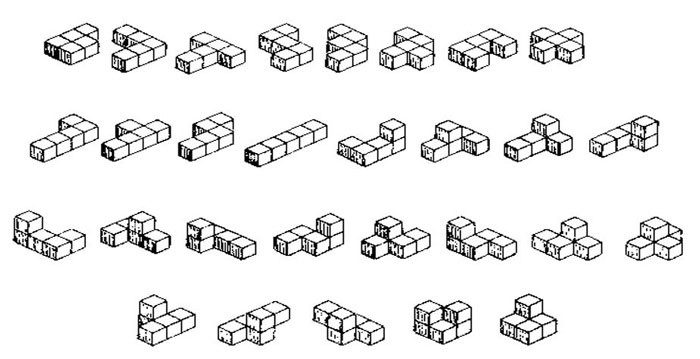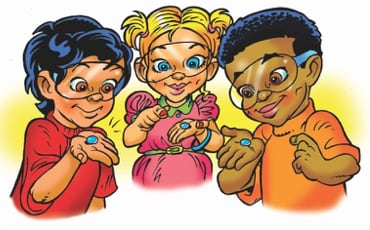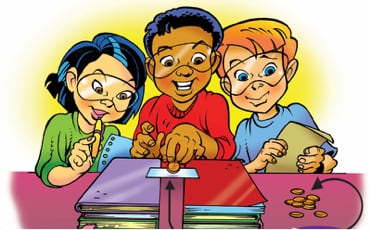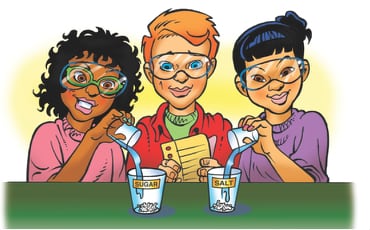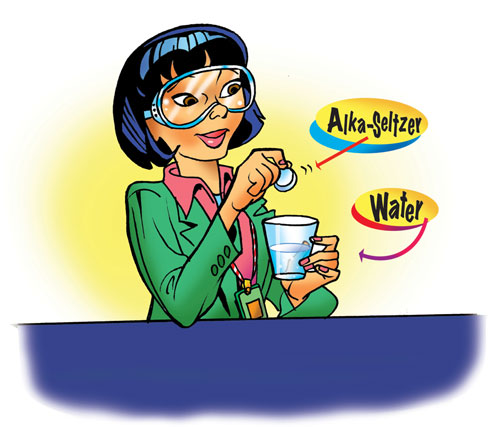Lesson Overview for Teachers
View the video below to see what you and your students will do in this lesson.
Objective
Students will be able to explain that the parts of an object can be rearranged to create a new object. Students will also get a sense of the number of different objects that can be created from a small number of parts and will apply this to modeling atoms and molecules.
Key Concepts
- An object made of small parts can be taken apart and the parts can be rearranged to make a new object.
- Matter is made up of very small parts called atoms.
- Atoms in different numbers and combinations make different molecules.
NGSS Alignment
- NGSS 2-PS1-3: Make observations to construct an evidence-based account of how an object made of a small set of pieces can be disassembled and made into a new object.
Note: The NGSS performance expectation does not specifically make a connection between rearranging “a small set of pieces” and the idea of rearranging atoms to form different molecules. The lesson goes in this direction to build the concept that matter is made up of a relatively small set of building blocks called atoms and that atoms can be arranged in different ways to make molecules and all the different substances around us.
Summary
- Students are introduced to the idea that a small number of units or pieces can be used to make different objects and that the pieces from one object can be taken apart and put together in different ways to make new and different objects.
- Student groups are given four Snap Cubes and guided to use the four cubes to make eight different objects.
- Each student is given a picture of one of the possible 29 different objects that can be built from five snap cubes and students build their object.
- After students build their object, all 29 are displayed for the class to see.
- Students do an anagram activity to see that letters, like atoms, can be rearranged to make different words, molecules.
Evaluation
Copy the Anagram Worksheet (PDF) and distribute one per student when specified in the activity. The activity sheet will serve as the Evaluate component of the 5-E lesson plan.
Safety
No goggles required.
Materials
- 2 sets of Snap Cubes (100 per set)
- 2 Object Sheets (PDF) (8 objects pictured for activity with 4 cubes)
- 4 Object Sheets (PDF) (29 objects pictured for activity with 5 cubes)
Materials for each group
- 4 Snap cubes of the same color
Teacher preparation:
Snap cubes can be purchased at:
- hand2mind (ETA) http://www.hand2mind.com/item/snap-cubes-set-of-100/5486
- Amazon https://www.amazon.com/Learning-Resources-Mathlink-Cubes-Set/dp/B000URL296,
- Lakeshore Learning http://lakeshorelearning.info/seo/p%7CRA529~~.jsp
They also go by the name Pop Cubes, Linking Cubes and Mathlink Cubes.
Divide the class into groups of two or three students each. Give each group a set of four snap cubes of the same color.
Note: Many classrooms have snap cubes. You may want to ask around your school before purchasing. You will need to purchase two sets of 100 to have enough for the second part of the lesson, which will use a total of 145 cubes.
Print out and laminate (optional) the 2 sheets containing the 8 object cards. Cut the sheets in quarters so that each object is on a quarter-sheet of paper.
For the Extend part of the lesson, print out and laminate (optional) the 4 sheets containing the 29 object cards. Cut the sheets in eighths so that each object is on an eighth-sheet of paper.
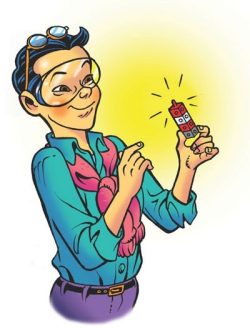
ENGAGE
1. Explain and demonstrate how students will use the Snap Cubes to make different objects.
Tell students that the class will work in groups with little cubes called Snap Cubes. Explain that the group will practice taking apart and putting the cubes together to make as many different shapes as possible from their cubes.
- Show four cubes together in a straight line. Also show the object card of four cubes in a row that makes a straight stick object.
- Next, demonstrate and have students take one cube off either end and attach it to make an “L” shape as shown. Show students the object card for this shape. Explain to students that taking that one cube off and attaching it to a new place makes a new object.

- Use magnets or tape to post pictures of the first two objects you have shown students. Let students know that there are eight different objects that can be made from four cubes.
Note: Be sure students understand that just turning the object over or rotating it does not make a new object. It is still the same object, just moved around.
EXPLORE
2. Have students use their cubes to make as many different objects as they can.
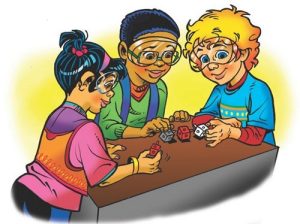
Question to investigate: How many different objects can be made from four cubes?
- Ask groups to make an object that is different from the two that you have made and to show the object when they are done.
Go around the room and see the objects students are making. As you see a new object a group has made, post the picture of that object for other groups to see. Ask groups to try to make the other missing objects. As groups show you their objects, add them to the list until all eight possible different objects have been created and posted.
After students have created all eight objects, point out again that it was possible to make eight different objects from just four cubes.
3. Lead the class in making 29 different objects from five cubes.
Tell students that if they add 1 more cube, so that there are 5 cubes, they can make 29 different objects! Tell students that each of them will have one object to make and that the class will display all of them so everyone can see.
- Give each student 5 cubes of the same color.
- Distribute one object card to each student and have them construct the object on their card.
- Have students place all 29 different objects on a table so students can see them all. If you have fewer than 29 students, you may want to make the extra objects ahead of time, so each student still builds one object (or you can choose a few students to make two).
EXPLAIN
4. Show an animation of snap cubes used as models of atoms to make different molecules.
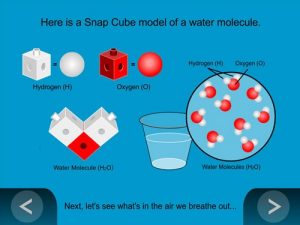
Show the animation Models of Atoms and Molecules.
Explain that Snap Cubes can be models of atoms that join together to make molecules. Everything in the world is made up of tiny little particles called atoms. Some common atoms that are in a lot of different things are carbon, oxygen, and hydrogen. These atoms can be arranged in different ways to make different molecules and substances. Tell students that in another lesson, they will use Snap Cubes to make different molecules.
EXTEND
5. Use the analogy of rearranging letters to make different words to explain that atoms can be rearranged to make different molecules.
- Explain to students that atoms are kind of like letters in the alphabet. There are only 26 different letters but they can be arranged in many different ways to make thousands of different words. In fact, the letters of a word can be taken apart and rearranged to make a new word. These are called “anagrams.”
- Give students the Anagram Worksheet (PDF).
- Show how the letters in the word “DEAR” can be rearranged to make the word “READ”. Be sure to explain that the “R” and the “A” are already in the right place in the new word so students just need to figure out where the “D” and the “E” go to make a new word.
- If students need more guidance, do another example. Have students figure out the rest of the words in class or for homework.


